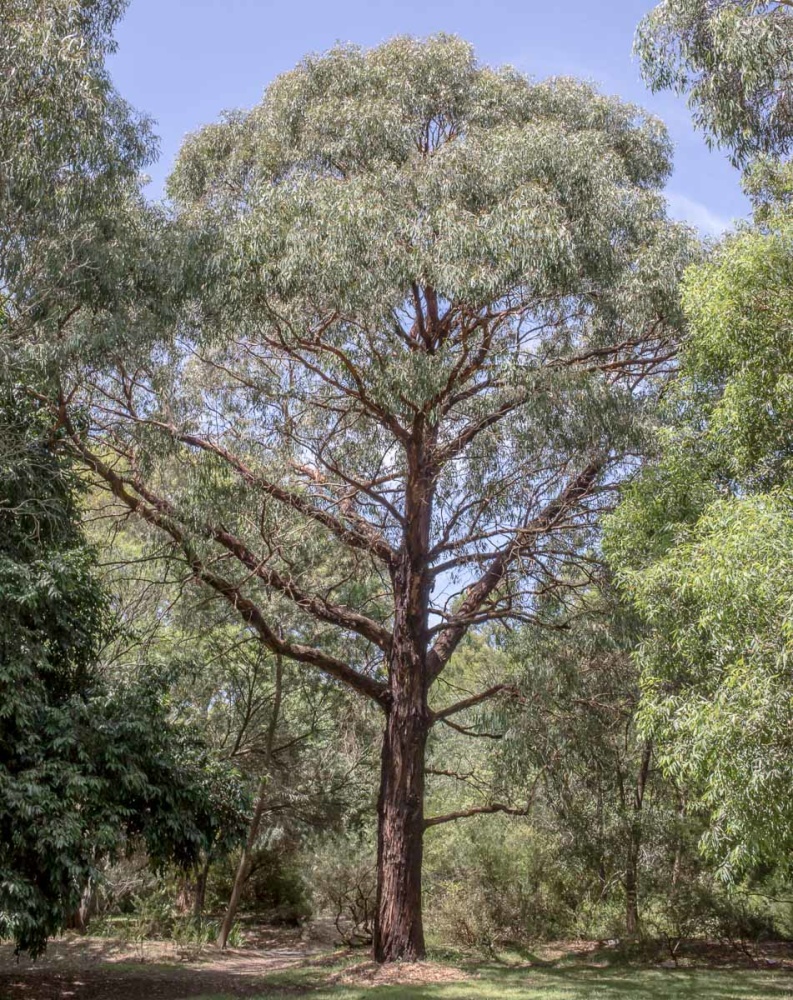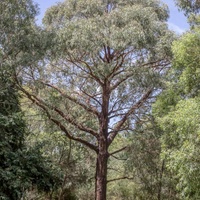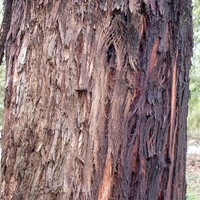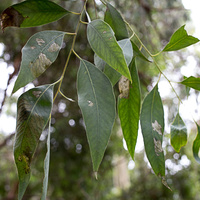Common name: Narrow-leaved peppermint
Other common names: Black peppermint, Forth River peppermint, Grey peppermint, New South Wales messmate
Description
Narrow-leaved peppermint is an essential-oil yielding eucalyptus native to eastern Australia, its natural range extending from near Melbourne in Victoria, through Ballarat and Gippsland to the high country of New South Wales, as far north as the Queensland border.
On favourable forest sites, it may attain a height of up to 50 m (164 ft), with a trunk diameter of 1.5 m (5 ft). However, it is typically around half that height, with a straight trunk supporting a moderately branched crown. On open sites, it is somewhat shorter and develops a large, rounded crown. The bark is grey or dark brown, on young trees smooth, becoming vertically fissured, fibrous and strappy with age.
Like other eucalyptus species, the leaves change shape as the tree matures. In this species, from pairs of stalk-less, dull green broadly lance-shaped leaves on young trees to alternately arranged long-stalked, dull green lance-shaped leaves on mature trees. They remain on the tree throughout the year and release a strongly menthol-like aroma when crushed.
The flowers are typical of a eucalypt, being perfect (bisexual) and small, with long, creamy-white filaments set in a cup-shaped base. They arise at the sides of the branches, usually in groups of eleven to twenty and bloom from spring through summer.
Fertilised flowers develop into small, goblet-shaped seed capsules that become dark brown and woody when they mature with tiny, glossy brown, pyramidal-shaped seed inside.

Maranoa Gardens, Melbourne, Australia
Use
The leaves on steam distillation yield 3 to 5% eucalyptus oil of two distinct types, depending on the variety. The variety known as 'A' yields eucalyptus oil with a high cineole (aka. eucalyptol) content, the most valuable of the Eucalyptus oils due to its medicinal and antiseptic qualities. It is almost identical in composition to the oil from Broad-leaved peppermint (Eucalyptus dives), a closely related eucalyptus species that it overlaps with in its native distribution.
Cineole-type eucalyptus oil is a proven expectorant, antiseptic and antibacterial, particularly against Streptococcus. It is used in cough drops and syrups, vaporiser fluids, ointments, liniments, gargles and oral hygiene products such as toothpaste and mouthwash. It is also commonly used in dentistry, particularly in solvents and sealers for tooth fillings after root canal surgery.
Cineole-type oils are also a good stain remover, having proven effective in removing grease, glue and dried stains from skin and clothing. Eucalyptus oils are generally used in cleaning, mould removal, disinfecting, perfumery, pharmaceutical, personal care and pest insect control products.
The variety known as 'B' produces an oil unsuitable for medicinal purposes. Still, it has a robust and peppery-camphoraceous aroma, making it interesting to the fragrance industry. A significant amount is also produced and used in the mining industry to create froth to separate floating from non-floating minerals and as a solvent or hardener in paints and lacquers.
When extracted, both 'A' and 'B' type oils are colourless but age to pale yellow, especially under long or poor storage conditions.
The timber is moderately heavy, averaging 720 kg per cubic meter (45 lbs per cubic ft) and has light-brown heartwood. However, it shrinks significantly on seasoning and is not durable. It has low natural resistance to rot, decay and wood-boring insects. It is mainly used for indoor construction or other applications where a durable wood is not required.
Narrow-leaved peppermint develops an attractive form on sites with adequate moisture and deep soil, with a straight trunk and large, densely leafy crown. In Australia, local town councils recommend planting it as an amenity tree in town parks and public gardens.
Climate
Narrow-leaved peppermint grows naturally in humid subtropical and warm-temperate climates, generally areas with annual lows of 5 to 12°C, annual highs of 16 to 25°C, annual rainfall of 600 to 1400 mm and a summer or winter dry season of 5 months or less.
Growing
New plants are mostly grown from seed, which germinate readily. The seed are sown in containers with a free-draining potting mix and usually germinate within two to five weeks. Seedlings are then tended in a nursery until around 30 to 50 cm tall, then planted out.
Narrow-leaved peppermint performs best on free-draining clay-loam, loam, sandy-loam and loamy-sand soils of a moderately acid to slightly alkaline nature, generally with a pH of 5.0 to 7.5, and on sites with full to partial sun exposure. It has poor tolerance to waterlogged or poorly drained soils.
Problem features
None known
Where it grows
References
Books
-
Arctander, S. 1960, Perfume and flavor materials of natural origin, Elizabeth, New Jersey
-
Boland D.J., Brophy J.J. & House A. P. N. 1991, Eucalyptus leaf oils, use, chemistry, distillation and marketing, Australian Centre for International Agricultural Research (ACIAR) & Commonwealth Scientific Industrial Research(CSIRO), Inkata Press, Melbourne
-
Boland, D. & Brooker, I. & McDonald, M. W. 2006, Forest trees of Australia, 5th ed., CSIRO Publishing (Ensis), Melbourne
-
Brady, G. S. & Clauser, H. R & Vaccari, J. A. 2002, Materials handbook : an encyclopedia for managers, technical professionals, purchasing and production managers, technicians and supervisors, 15th ed., McGraw-Hill, New York
-
Cribb, A. B. & Cribb, J. W. 1982, Useful wild plants in Australia, William Collins, Sydney
-
F. R. Beuhne 1922, Honey flora of Victoria, Melbourne Albert J. Mullett, Govt. printer
-
Jacobs M. R. 1979, Eucalypts for planting, Food and Agriculture Organization of the United Nations (FAO), Rome
-
Scheffer, T. C & Morrell, J. J. 1998, Natural durability of wood : a worldwide checklist of species, Forest Research Laboratory, Oregon State University, Corvallis, Oregon
-
Streets, R. J. & Troup, R. S. 1962, Exotic forest trees in the British Commonwealth, Oxford University Press, Oxford, England
Articles, Journals, Reports and Working Papers
-
Ciesla W.M. 2002, Non-wood forest products from temperate broad-leaved trees, FAO Technical Papers 15, Food and Agriculture Organization of the United Nations (FAO), Rome




